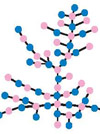I’m not sure how I missed this when it came out, but two years ago, Peter Bearman (go Columbia!) and colleagues used extremely detailed data gathered as part of the Adolescent Health Project to map the romantic and sexual network of 832 of the 1,000 students at a large high school somewhere in the Midwest. The results of their research is the American Journal of Sociology article “Chains of Affection” (the full PDF of the article available here, from the home page of one of the other sociologists who was involved in the study), and it’s a hell of an interesting read. The relationship map was put together with the dual intents of getting a better sense of the disease transmission risks faced by high school students and of figuring out optimal strategies for implementing social policy changes, and there are a few things that came out of the study that are pretty amazing to me.
The most noticeable part of the map is that there is a huge, interconnected network containing more than half of the romantically-involved students in the school — all in all, there are 288 students who share common links in their relationships. Within this subgroup, students were separated by as many as 37 steps, and while some members of the subgroup only had one other partner, others had as many as nine. (Fascinating to me is that the 37-degree separation actually forms a completely circular core of this network — you can start with any of the 37 students, start tracking that individual’s relationships, and end up coming right back to that same individual.)
While those 288 students all formed a large, branching relationship network, 126 others formed 63 separate monogamous relationships, and 63 students formed 21 three-person networks. That’s interesting in and of itself, since it reflects nearly 200 students who were relatively isolated from sexual risks. There were also only two same-sex relationships identified in the network (one within the large network, and one within a much smaller grouping of relationships); that number is small enough to make me at least wonder whether the researchers identified every single relationship in the school. Due to the design of the study’s data-gathering methods, students weren’t asked about relationships that they had with non-students, so that’s probably another place where there are a couple unknown links in the network.
All in all, Bearman and his study group put together a pretty amazing look at the sexuality of students in an average high school, and effectively drive home the real risks that parents, educators, and public health officials need to acknowledge.



I find it interesting that of all the displayed couplings, I could only see three homosexual ones (two male, one female), and of those involved, only one student was exclusively homosexual (and he was also the end of a chain). This tells me there’s sampling bias and/or homosexual students largely still don’t feel comfortable expressing their preference in high school.
I wonder what maps would look like in all sorts of different situations now (different high schools in different parts of the country, different colleges in different parts of the country, dating circuits in different major metropolitan areas, etc.) though of course most of the interesting things would probably be visible only at a VERY large scale.
• Posted by: fluffyActually, I don’t find it at all surprising that there are so few homosexual relationships. About 1% of the population will be homosexual, so that’s about 8 students, or 4 of each gender (actually, it would probably be something like 5 males and 3 females). Some subset probably haven’t realized they are gay yet, or come out of the closet.
So, basically, each gay student is really only looking at one or two potential partners, whom they may or may not be attracted to, and whose social circle they may not run in…
• Posted by: PLC on Feb 25, 2007, 5:43 PM